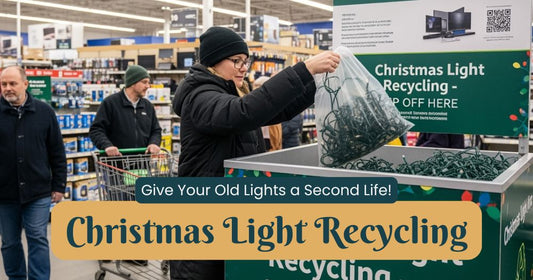Christmas Light Power Planning 101: Exactly How Many Lights You Can Run on One Circuit
If you’ve ever asked “how many Christmas lights can I run on one circuit?” this Christmas light power planning guide is for you. With a few quick formulas and smart accessories, you’ll design a brighter, safer display, avoid mid-season GFCI trips, and keep installation tidy enough to make Santa jealous.
The quick answer (and why it matters)
Here’s the fast math most decorators use. Standard household voltage is about 120V. A typical 15A circuit should be treated as 80% max for continuous loads (anything on for 3+ hours), and the same idea applies to 20A circuits unless the breaker is marked for 100% continuous duty. That means target loads of about 12A on a 15A circuit and 16A on a 20A circuit. The 80% guidance comes from electrical product/application rules for breakers; unless a breaker is specifically rated for 100% continuous operation, assume 80% as your safe ceiling. Source: UL guidance on continuous loading of circuit breakers.
Example capacity at 120V (using the 80% rule):
- 15A circuit safe target: 12A x 120V ≈ 1,440 watts
- 20A circuit safe target: 16A x 120V ≈ 1,920 watts
What does that mean in lights?
- Modern LED minis often draw roughly 3–6 watts per set and C7/C9 LED bulbs typically use under 1 watt each, so you can run a lot of LED before hitting those limits. LEDs also save significant energy versus incandescents. Energy.gov notes LEDs use about 70–80% less energy than traditional strands.
- Incandescent strings draw much more. With old-school minis, you can hit your wattage ceiling fast, and many authorities still advise no more than three incandescent strings end‑to‑end for safety. See ESFI’s holiday safety tips.
Step 1: Do the simple circuit math
Use these two formulas for Christmas light power planning:
- Watts = Volts × Amps
- Amps = Watts ÷ Volts
At 120V, add up the total watts on a circuit and divide by 120 to estimate amps. Keep the total under 80% of the breaker rating. Unless your breaker and enclosure are explicitly marked for 100% continuous load, treat your Christmas display as continuous and stick to that 80% ceiling. Reference: UL breaker application guidance.
Pro tip: Work by outlet, not room. A single 15A receptacle may share a circuit with other outlets and indoor loads. If a vacuum or space heater trips your lights, that circuit is already busy.
Step 2: Estimate real-world load for LEDs vs. incandescents
- LED example: Ten strings at 5 watts each = 50 watts. 50 ÷ 120 ≈ 0.42 amps. Plenty of headroom remains.
- C9 LED example: 100 bulbs at 0.8 watts each = 80 watts total. 80 ÷ 120 ≈ 0.67 amps.
- Incandescent example: Ten strings at 40 watts each = 400 watts. 400 ÷ 120 ≈ 3.33 amps. You’ll approach limits quickly as you scale.
Want bright, efficient rooflines with classic shape? Choose LED C7/C9 and mind spacing instead of wattage. Explore vivid, dimmable options in our C9 LED bulbs collection.
Step 3: Plan your branch runs and reduce voltage drop
Long cord runs can increase resistance and voltage drop, which can dim bulbs or cause nuisance trips in wet weather. Break your design into shorter, cleaner branches that feed from multiple outlets. Where you need custom lengths (to eliminate cord spaghetti), build professional, exact‑fit jumpers using SPT wire and slide‑on plugs.
- Learn the difference between SPT‑1 vs. SPT‑2 insulation and match your plugs to the wire type.
- Create tidy, custom leads and in‑line tap points with our Slide‑On Vampire Plugs collection. Inline female pass‑throughs let you drop power exactly where you need it on a run.
Step 4: Keep moisture out and GFCIs happy
Outdoor displays should be plugged into GFCI‑protected receptacles and use lighting rated for outdoor use. That’s not just best practice—it’s safety 101 from consumer safety agencies. CPSC guidance recommends GFCI protection and outdoor‑rated sets for exterior displays.
Moisture is the #1 Grinch. A little water in a plug can trip GFCIs repeatedly. Do this:
- Elevate connections and form drip loops.
- Use covers and gaskets at plug junctions. Our Weatherproof Plug Gaskets & Covers help keep water out so the show stays on.
- Keep unused C7/C9 sockets sealed to block water ingress. See socket covers.
Step 5: Choose the right cords and clips
- Extension cords: Use cords rated for outdoor use and appropriate gauge for the load and length. Protect cords from pinch points and never bury connections. ESFI recommends checking for certification labels (UL/ETL/CSA) and avoiding overloads. Read ESFI’s safety checklist.
- Light clips: Skip nails and staples. Purpose‑built clips are faster, cleaner, and protect your wiring. Shop our Christmas Light Clips to match gutters, shingles, ridgelines, and wireframes.
Step 6: Automate the on/off schedule
Automation saves energy and ensures lights aren’t left on overnight. Pair a photocell with a shut‑off timer or use a programmable outdoor timer or smart plug. Energy.gov recommends timers and photosensors to prevent lights from operating when not needed. See DOE’s lighting controls overview. Browse our Timers & Triple Taps to set‑and‑forget your display.
Handy reference table: safe circuit targets and examples
| Circuit | Safe continuous target (80%) | Approx. LED minis (5W set) | Approx. C9 LEDs (0.8W bulb) |
|---|---|---|---|
| 15A @ 120V | ~1,440 watts | ~288 sets | ~1,800 bulbs |
| 20A @ 120V | ~1,920 watts | ~384 sets | ~2,400 bulbs |
Notes: These are theoretical maxima. Real designs should be split across multiple outlets, consider cord lengths/voltage drop, and include margin for wet weather and other household loads.
Avoid these common mistakes
- Daisy‑chaining long extension cords to gain distance. Instead, make custom SPT jumpers or start a new branch from a nearer outlet.
- Mixing incandescent and LED on the same run. Incandescent inrush and higher wattage can cause nuisance trips; keep runs consistent.
- Ignoring shared circuits. A garage or exterior outlet often shares a breaker with interior lights or equipment.
- Exceeding manufacturer limits. Some products specify maximum end‑to‑end connections—follow them.
- Skipping GFCI protection or using indoor‑only cords outside. Both are big no‑nos. CPSC and ESFI emphasize GFCI use and proper ratings.
Sample power plan you can copy
Let’s say you want: a C9 LED roofline, two net lights per shrub (six shrubs), and a small tree wrap.
- List loads
- Roofline: 100 C9 LEDs at 0.8W = 80W
- Nets: 6 nets at 15W = 90W
- Tree wrap: 8 LED mini sets at 5W = 40W Total ≈ 210W → 210 ÷ 120 ≈ 1.75A
- Assign outlets and branches
- Branch A (right roofline + 3 nets): ~125W
- Branch B (left roofline + 3 nets + tree): ~85W
- Build clean connections
- Make two custom 18AWG SPT‑1 jumpers to reach roof corners with no slack, and add one inline female tap for the tree wrap using Slide‑On Vampire Plugs.
- Use gutter/shingle clips from our Clips collection to keep lines straight.
- Weatherproof and automate
- Cap any unused C9 sockets and gasket every plug junction.
- Use an outdoor photocell timer from our Timers collection set dusk–11pm. DOE notes timers and photosensors help cut wasted runtime.
- Final check
- Circuit headroom: 1.75A on a 15A circuit = plenty of margin.
- Night test: Turn everything on, walk the line, and confirm no dim zones or sagging cords.
FAQs
- How many LED strings can I connect? Check each product’s “max end‑to‑end” spec first. From a circuit perspective, sum watts and stay under 80% of the breaker rating for continuous loads. UL’s breaker guidance explains the 80% assumption.
- Why are LED lights so much easier on power? LEDs convert electricity to light far more efficiently than incandescent filaments and typically use 70–80% less energy. Energy.gov overview.
- Do I really need a GFCI outside? Yes—exterior lighting should be on GFCI‑protected circuits and use outdoor‑rated equipment. CPSC holiday safety.

- What else can reduce nuisance trips? Keep connections elevated and covered, avoid overlong runs, seal empty sockets, and avoid mixing incandescent with LED on the same branch.
Ready to power up—safely and beautifully?
If you’d like help turning this plan into parts, our elves are here for you. Start with Slide‑On Vampire Plugs to custom‑fit your cords, add an outdoor Timer or Photocell, and button up every junction with Weatherproof Plug Gaskets & Covers. Then pick your perfect C9 LED bulbs and let the glow begin!






